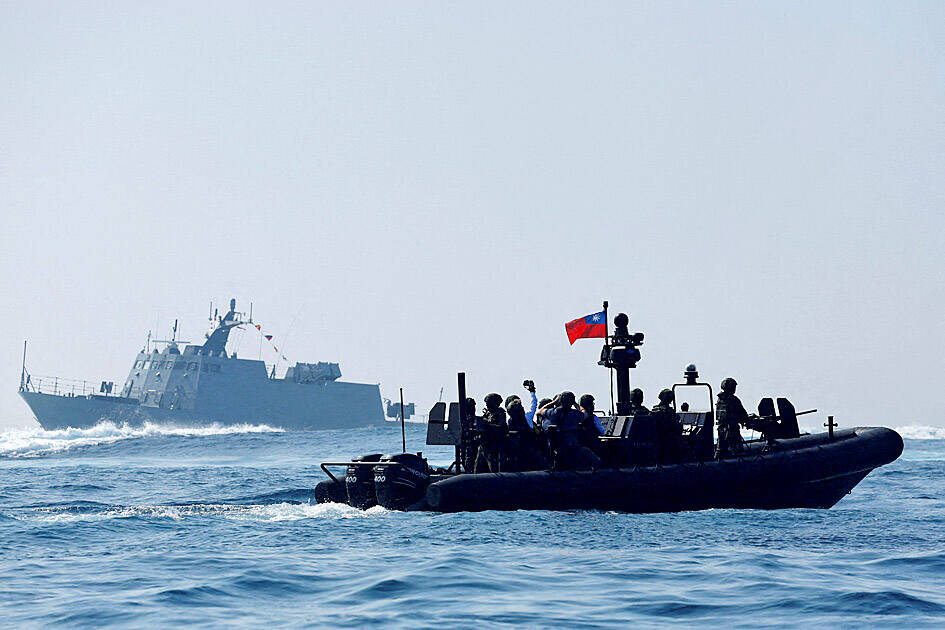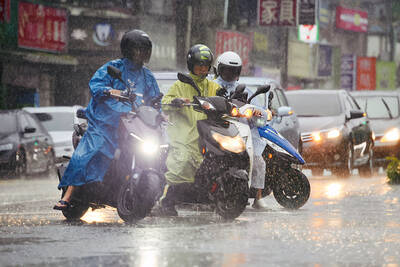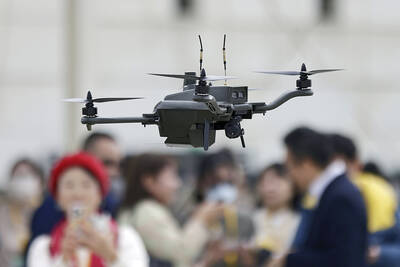An unpublicized joint military exercise between Taiwan and the US in the Pacific Ocean last month was carried out in accordance with an international code, the Ministry of National Defense (MND) said yesterday.
According to a Reuters report citing four unnamed sources, the two nations’ navies last month conducted joint drills in the Western Pacific.
The drills were not made public at the time, but “about half-a-dozen navy ships from both sides, including frigates and supply and support vessels, participated in the days-long exercises,” Reuters reported, citing the sources.

Photo: Carlos Garcia Rawlins, Reuters
The drills were designed to practice “basic” operations such as communications, refueling and resupplies, the sources said.
Ministry spokesman Major General Sun Li-fang (孫立方) said that the drills were based on the Code for Unplanned Encounters at Sea (CUES), a series of non-binding rules to prevent an escalation of tensions between militaries at sea.
Routine drills were carried out in accordance with CUES to avoid mutual interference during encounters at sea, because there are many uncertain factors during any such encounters, Sun said.
An agreement reached at the 2014 Western Pacific Naval Symposium, CUES offers safety measures and a means to limit mutual interference, to limit uncertainty and to facilitate communication when naval ships or naval aircraft encounter each other in an unplanned manner.
“It’s like I am dining in this restaurant and you also happen to be here,” Reuters quoted a source as saying. “Then it looks like I am only sharing the same table with someone.”
A third source said that although the two navies’ “unplanned encounters” involved mostly basic exercises, such drills are vital to ensure they can operate together in times of emergency.
The two navies also practiced tactical maneuvers, including searching for underwater targets, the third source said.
The Pentagon declined to comment.
The Chinese Ministry of National Defense did not immediately respond to a request for comment.
The drills, which focused on communications and other operations and did not involve live-fire maritime exercises, were not the first held to simulate encounters between Taiwanese and US naval ships, a source familiar with the matter said.
In 2016, a Taiwanese flotilla composed of the Kang Ding and Cheng Ho frigates, as well as the Panshih combat supply ship, were returning from a goodwill voyage when they unexpectedly met the USS Chaffee, a destroyer, in waters off Hawaii, the Military News Agency reported.
The Taiwanese ships established contact with the US vessel, and exchanged speed and bearing information to ensure mutual navigation safety following CUES, it said.
Separately, the MND said in a statement yesterday evening that as of 5pm, 23 Chinese warplanes had been detected operating near Taiwan, 15 of which crossed the median line of the Taiwan Strait.
Joint surveillance units kept a close watch on the situation, and aircraft, ships and shore-based missile systems were deployed to respond appropriately, it said.
Meanwhile, asked about Chinese military activity ahead of the inauguration of president-elect William Lai (賴清德) on Monday next week, Sun said that peace in the Taiwan Strait and regional stability depend on the joint efforts of all parties.
Any provocative actions would not help regional peace and stability, and Taiwan’s military is not a troublemaker and will not take provocative actions, Sun said.
The Chinese People’s Liberation Army on Saturday deployed the Lishui, a Type 052D destroyer, in waters around Penghu County.
Major General Tung Chi-hsing (董冀星), who is in charge of combat and planning affairs at the MND, said that China has also been stepping up “gray zone” warfare against Taiwan.
The MND would continue its joint intelligence, surveillance and reconnaissance operations to stay on top of developments in the Taiwan Strait and respond to any emergencies based on combat readiness guidelines and regulations, Tung said.
Additional reporting by Wu Che-yu

The combined effect of the monsoon, the outer rim of Typhoon Fengshen and a low-pressure system is expected to bring significant rainfall this week to various parts of the nation, the Central Weather Administration (CWA) said. The heaviest rain is expected to occur today and tomorrow, with torrential rain expected in Keelung’s north coast, Yilan and the mountainous regions of Taipei and New Taipei City, the CWA said. Rivers could rise rapidly, and residents should stay away from riverbanks and avoid going to the mountains or engaging in water activities, it said. Scattered showers are expected today in central and

COOPERATION: Taiwan is aligning closely with US strategic objectives on various matters, including China’s rare earths restrictions, the Ministry of Foreign Affairs said Taiwan could deal with China’s tightened export controls on rare earth metals by turning to “urban mining,” a researcher said yesterday. Rare earth metals, which are used in semiconductors and other electronic components, could be recovered from industrial or electronic waste to reduce reliance on imports, National Cheng Kung University Department of Resources Engineering professor Lee Cheng-han (李政翰) said. Despite their name, rare earth elements are not actually rare — their abundance in the Earth’s crust is relatively high, but they are dispersed, making extraction and refining energy-intensive and environmentally damaging, he said, adding that many countries have opted to

SUPPLY CHAIN: Taiwan’s advantages in the drone industry include rapid production capacity that is independent of Chinese-made parts, the economic ministry said The Executive Yuan yesterday approved plans to invest NT$44.2 billion (US$1.44 billion) into domestic production of uncrewed aerial vehicles over the next six years, bringing Taiwan’s output value to more than NT$40 billion by 2030 and making the nation Asia’s democratic hub for the drone supply chain. The proposed budget has NT$33.8 billion in new allocations and NT$10.43 billion in existing funds, the Ministry of Economic Affairs said. Under the new development program, the public sector would purchase nearly 100,000 drones, of which 50,898 would be for civil and government use, while 48,750 would be for national defense, it said. The Ministry of

UNITED: The other candidates congratulated Cheng on her win, saying they hoped the new chair could bring the party to victory in the elections next year and in 2028 Former Chinese Nationalist Party (KMT) lawmaker Cheng Li-wun (鄭麗文) yesterday won the party’s chair election with 65,122 votes, or 50.15 percent of the votes. It was the first time Cheng, 55, ran for the top KMT post, and she is the second woman to hold the post of chair, following Hung Hsiu-chu (洪秀柱), who served from 2016 to 2017. Cheng is to succeed incumbent Eric Chu (朱立倫) on Nov. 1 for a four-year term. Cheng said she has spoken with the other five candidates and pledged to maintain party unity, adding that the party would aim to win the elections next year and